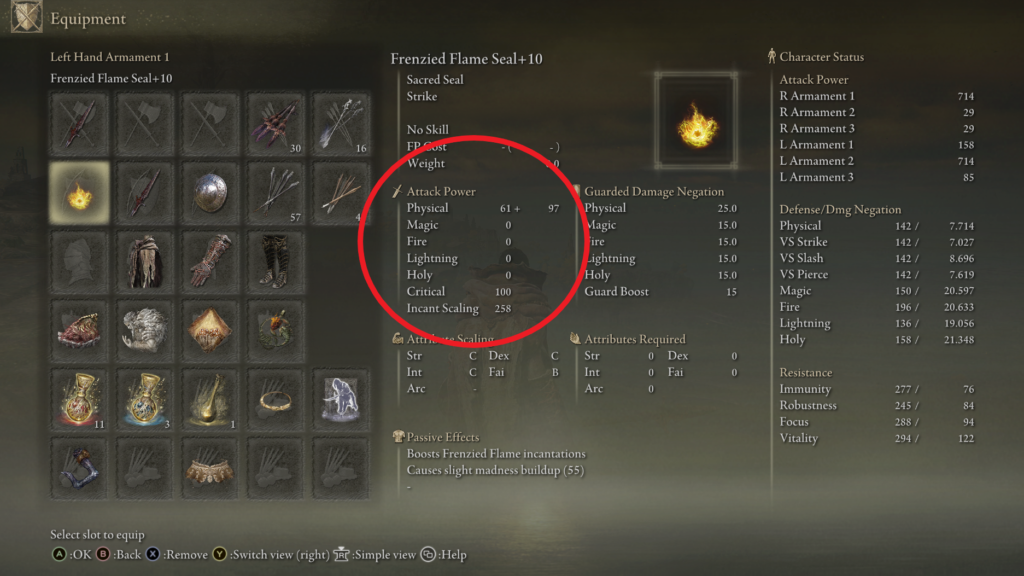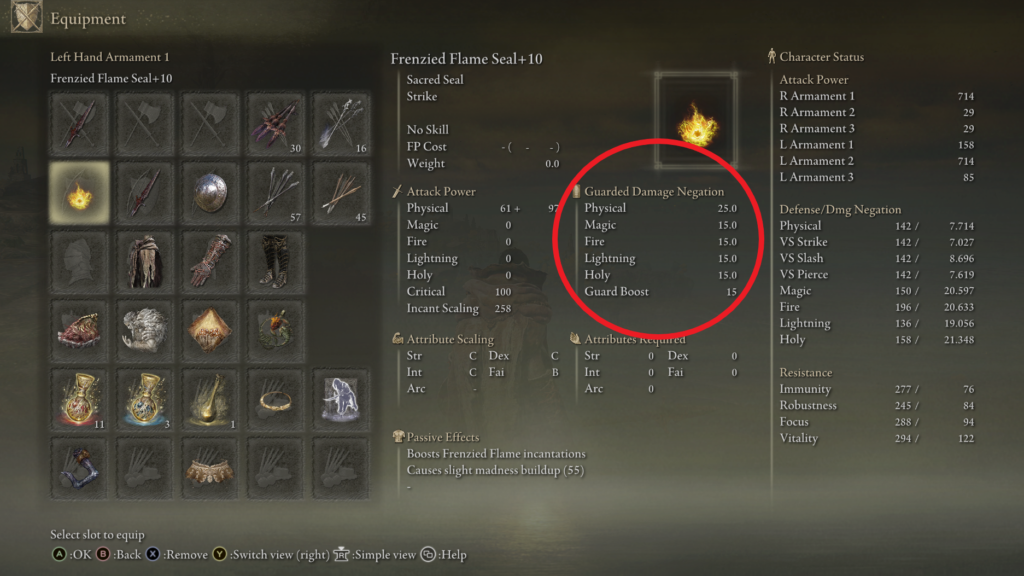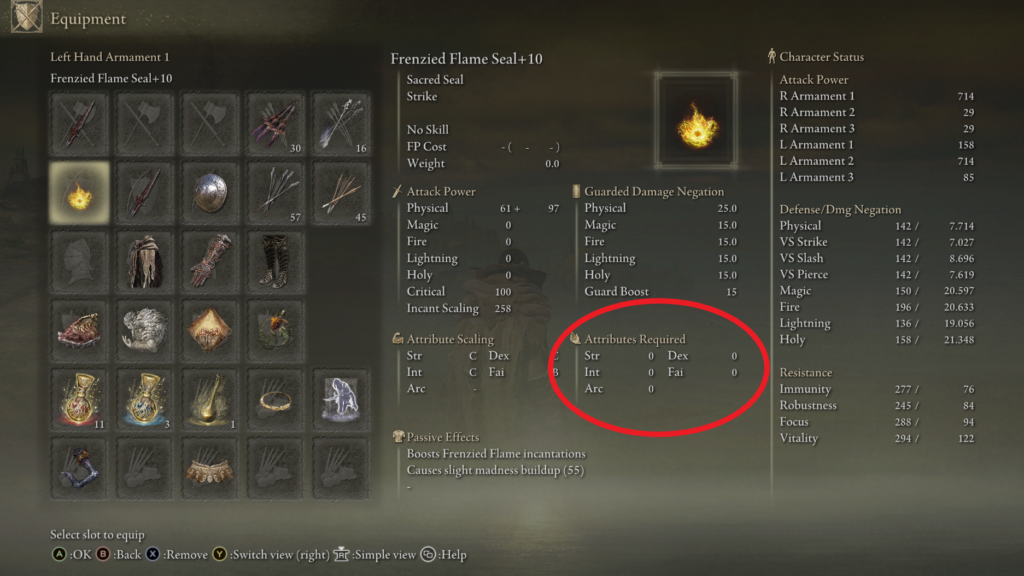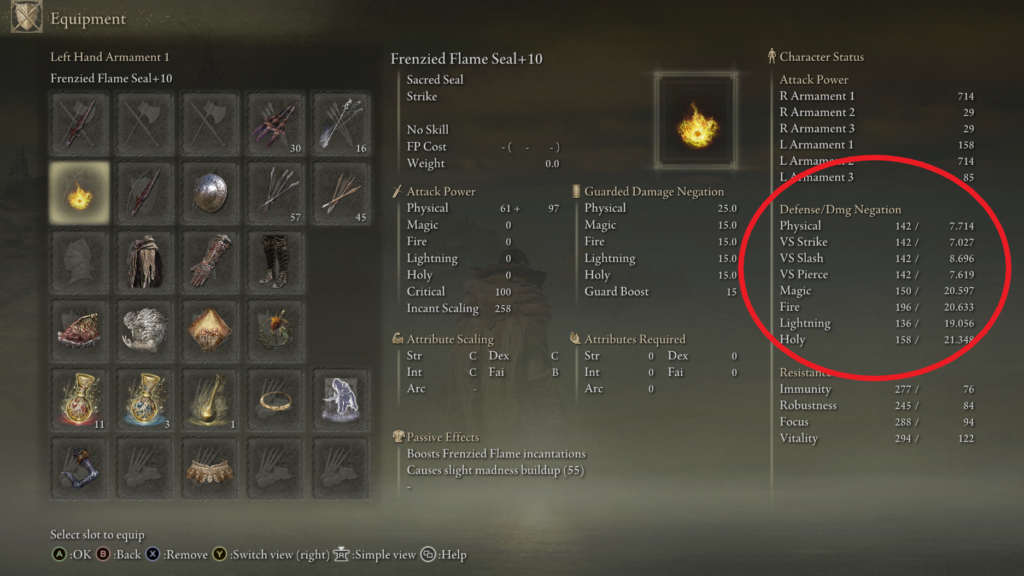When it comes to the user interface, Elden Ring pulls from the previous FromSoftware titles. Even with years of experience, these statistics and other details about weapon armaments, damage modifiers, and attribute scalings continue to confuse many players. Interpreting and understanding the various statistics associated with a particular weapon is crucial for predicting how a particular weapon will perform in combat, and necessary for determining its viability in a particular build.
Unfortunately for many, Elden Ring follows in its predecessors’ footsteps and FromSoftware did not do a great job of explaining what each category means or how it affects the player. Luckily, many of the statistics carry over from the previous Soulsborne titles, and we’ll cover what each line means in the guide below.

Attack Power
Starting from the top, attack power refers to how much raw damage a weapon will do in its current upgrade state. Often times, weapons will have a number in their physical category attributing the damage associated with a physical attack and making contact with an enemy.
The different types of weapons are associated with their particular type of damage — Magic is will do magic damage, fire will do fire damage, and so on. Critical refers to the multiplier applied to critical attacks. These are ripostes on parries or guard breaks and also backstabs. Sorcery Scaling is the degree by which sorceries increase in power; the higher the better.
The number on the left refers to the flat damage of the weapon and can only be changed by upgrading or reinforcing the weapon at a smith. However, the number on the right is where things get a little tricky for many to understand.

Attribute Scaling
This is the single-most challenging thing for players new to FromSoftware titles to interpret. The scaling system is not well explained within the game, and players are almost expected to know that “E-scaling” is the lowest and “S-scaling” is the highest. The issue really comes from what the different tiers determine.
For Elden Ring, attribute scaling refers to the additional weapon damage that comes from the player’s attributes. This can be any combination of Faith, Intelligence, Arcane, Dexterity, or Strength. To calculate the bonus damage, there’s a good amount of math done on the back end.
Using the Ruins Greatsword as an example with its S-scaling at +10, we can calculate the bonus damage strength adds to this weapon:
Part one: Physical Strength Calculation
If Strength Stat (99) > 80; (((Strength-80)/70) x 20) + 90 = 95.43
If Strength Stat (70) > 60; (((Strength-60)/20) x 15) + 75 = 82.5
Part two: Physical Strength Damage
(99 Strength); (95.43/100) x 1.8 x 303.8
Using the base physical damage of a +10 Ruins Greatsword, 303.8, we multiply it by the Strength Scaling modifier, 1.8, and also the percentage of the Physical Strength Calculation to get 521.84. This number gets rounded-down to 521 and is the additional damage that the player’s Strength stat provides.
There are different scaling modifiers used for the other tiers of scaling and these modifiers increase as the weapon is upgraded. The Ruins Greatsword scaling modifiers start at 1.0 and then increase by 0.08 each level. However, all weapons are different.

Passive Effects
Passive effects refer to additional attributes of a weapon. In the picture above, the Frenzied Flame Seal has a passive effect of causing slight self-madness buildup as you use it. At the same time, it also increases the power of Frenzied Flame incantations.
As shown, these passive effects can be to the benefit or detriment of the Tarnished. Oftentimes, the passive effect refers to a passive status build-up applied to the player’s target. Blood loss, Frostbite, and Scarlet Rot are a few examples of this.
The passive effects are also connected with the Arcane stat. As players increase their Arcane stat, the build-up of these statuses increases which in turn decreases the number of attacks required to proc the effect.

Guarded Damage Negation
Guarded Damage Negation refers to the damage that gets negated when a player is blocking. Shields are the best example of this. The physical stat associated with a particular shield is the percentage of that damage type that is negated when blocking. If a shield has 100.0 Physical Guarded Damage Negation, players will not take any physical damage from the incoming attack.
If an enemy is attacking with multiple damage types on a blocking player, then the player will likely take chip damage even if the shield has 100.0 Physical Guarded Damage Negation.

Attributes Required
These refer to the stats required to properly wield and use a weapon with one hand. Players can equip weapons that do not have the stats for but will not be able to effectively use the weapon with on hand. The exception to this is two-handing a weapon, which gives the player 1.5x their current Strength stat. Using the Ruins Greatsword from above as an example, it has a Strength requirement of 50 to use. Players can effectively use the Ruins Greatsword with two hands with a minimum Strength stat of 34. This does not work for Intelligence, Faith, or Dexterity based weapons.

Attack Power continued
Displayed on the right side of the screen is the attack power of different armaments. These are associated with the armaments the player has equipped. There are three potential slots for armaments in either the left or right hand, and this display shows the attack power of each one, respectively.
- R Armament 1 = Right hand slot 1
- R Armament 2 = Right hand slot 2
- R Armament 3 = Right hand slot 3
- L Armament 1 = Left hand slot 1
- L Armament 2 = Left hand slot 2
- L Armament 3 = Left hand slot 3

Defense/ Damage Negation
This is another area that continues to trip players up. A player’s defense (the number on the left) is associated with their specific stats. As the player continues to level up, these defense numbers will continue to increase, and they provide a base level of defense when damage is taken.
Damage negation refers to the percent of damage that is negated when hit. In the screenshot above, the physical damage negation is 7.714. This means about 7.7% of additional physical damage is negated after the base defense stats have been calculated. This number can be increased and influenced heavily by the type of armor the player chooses to wear. Though, those that wish to flash their “Elden Bling” may be willing to make the defensive compromise.

Resistance
Similar to the defense and damage negation, resistance has a number associated with the player’s attributes as well as equipment. The left number is connected to the player’s attributes and determines the character’s base level of resistance. The number on the right is the additional resistance provided by the player’s current equipment.
Here is what each resistance category means:
- Immunity – Character’s resistance to Poison and Scarlet Rot.
- Robustness – Character’s resistance to Hemorrhage (Blood loss) and Frostbite
- Focus – Character’s resistance to Sleep and Madness
- Vitality – Character’s resistance to Instant Death (Deathblight)
For each of these categories, the higher the resistance (higher number), the longer it takes to proc the Elden Ring status effect.






Published: May 15, 2022 08:25 pm